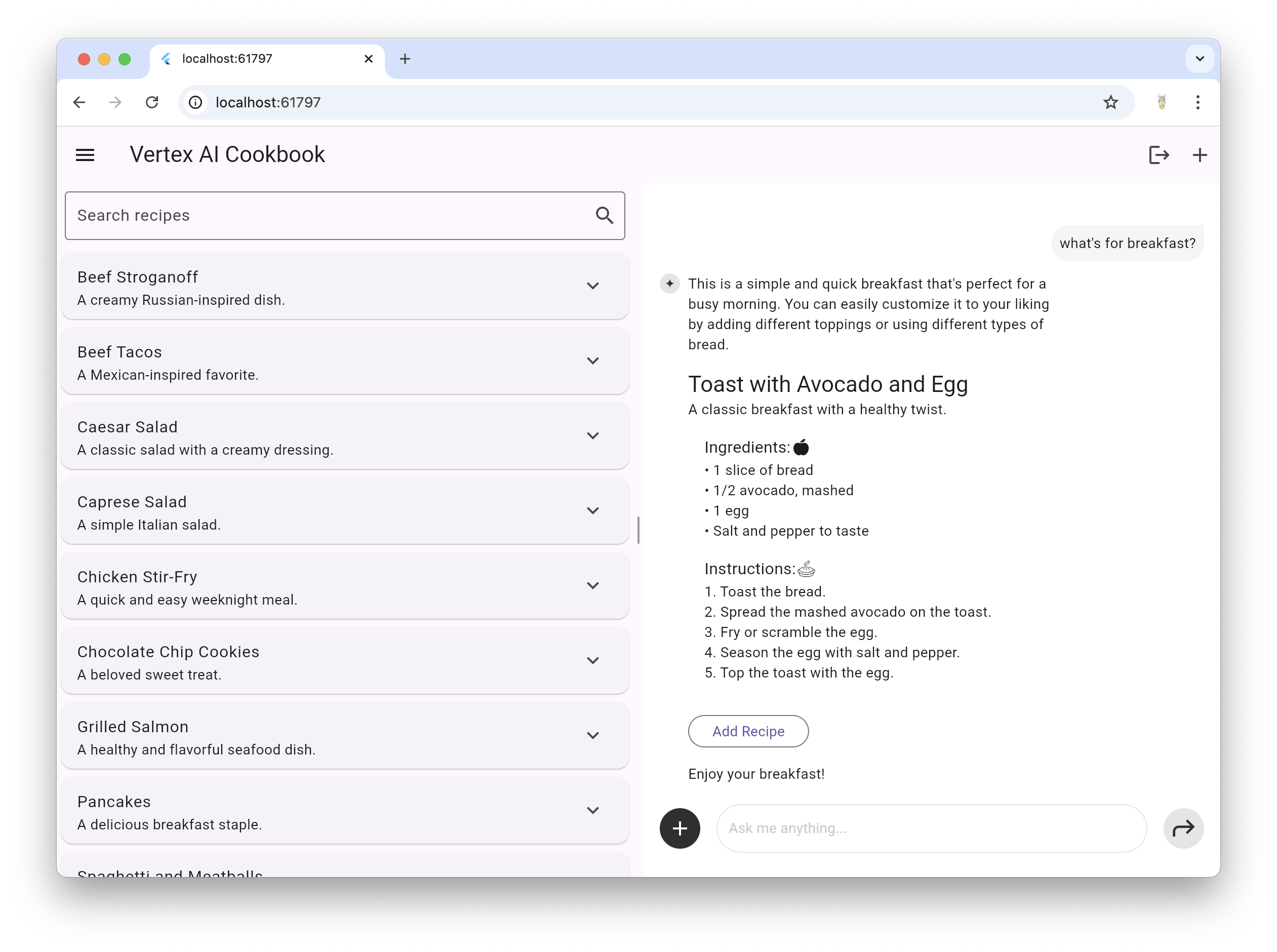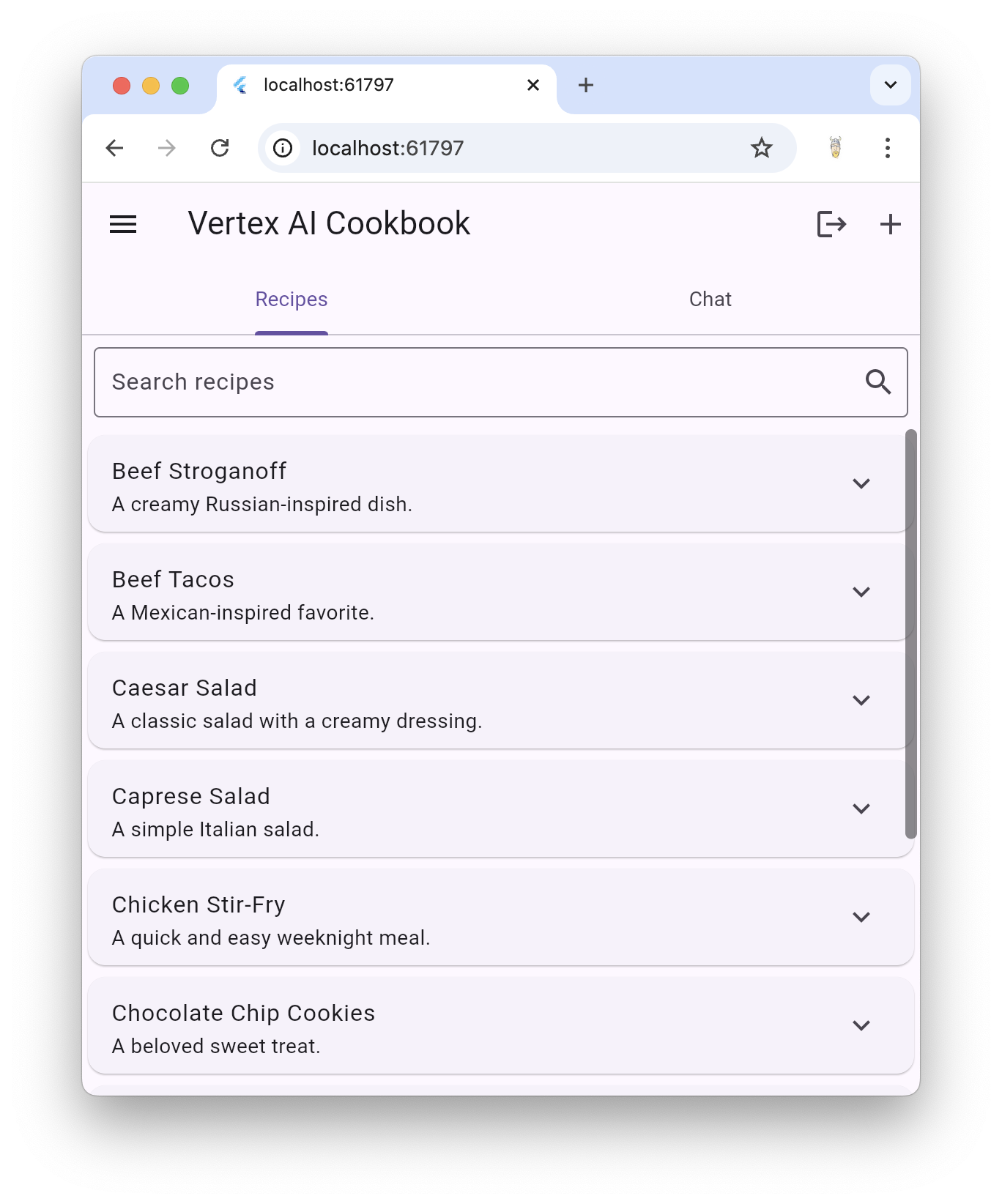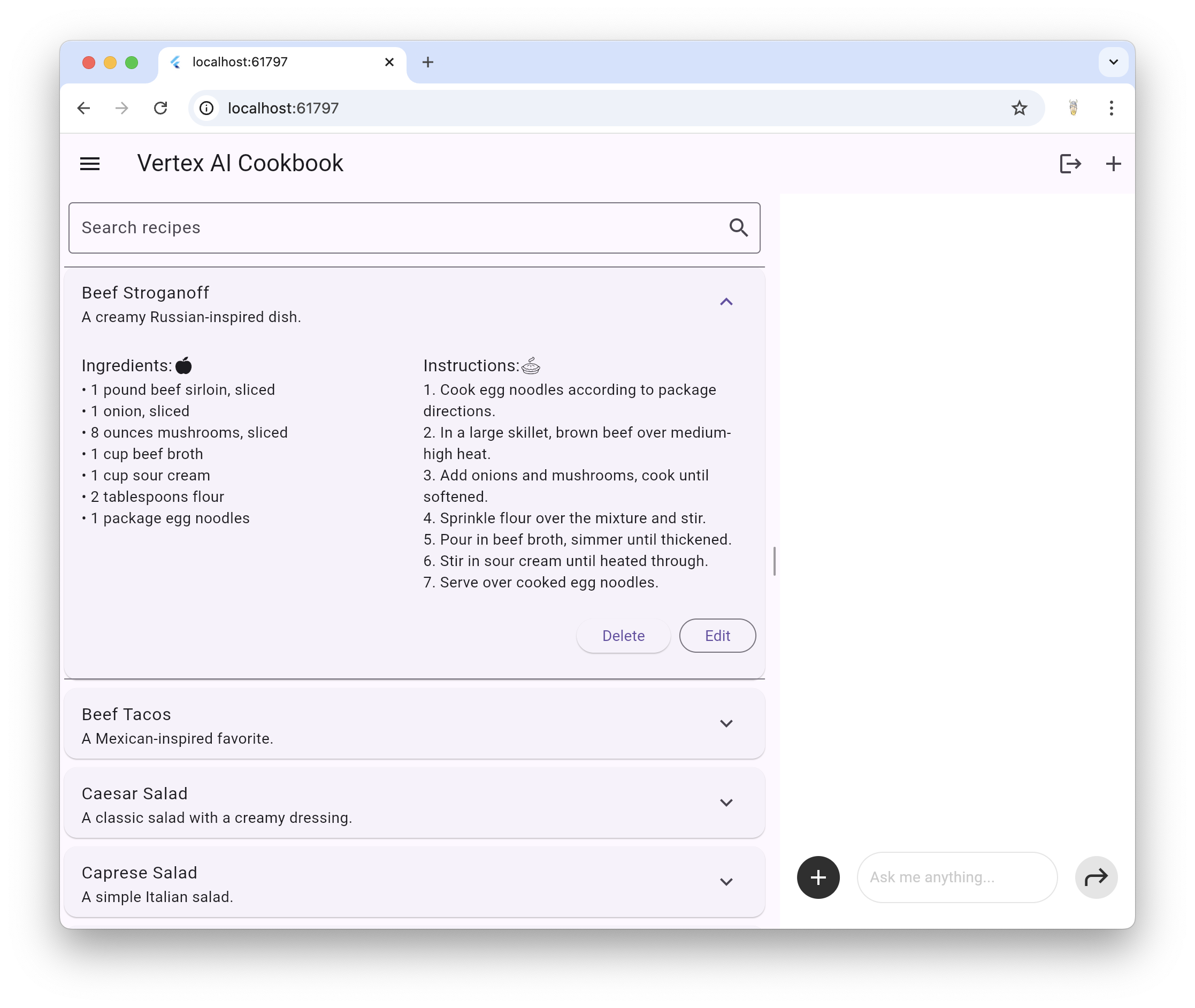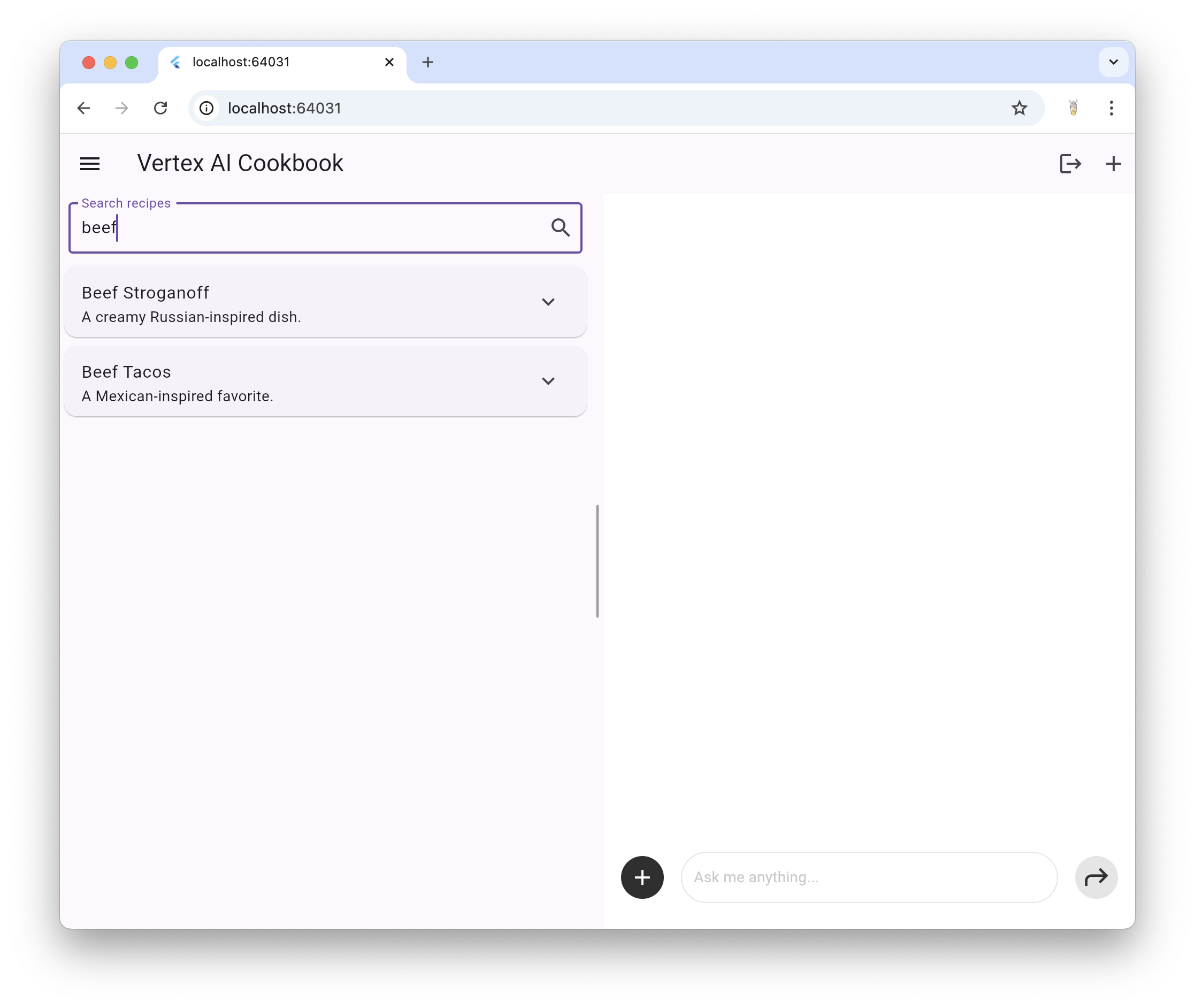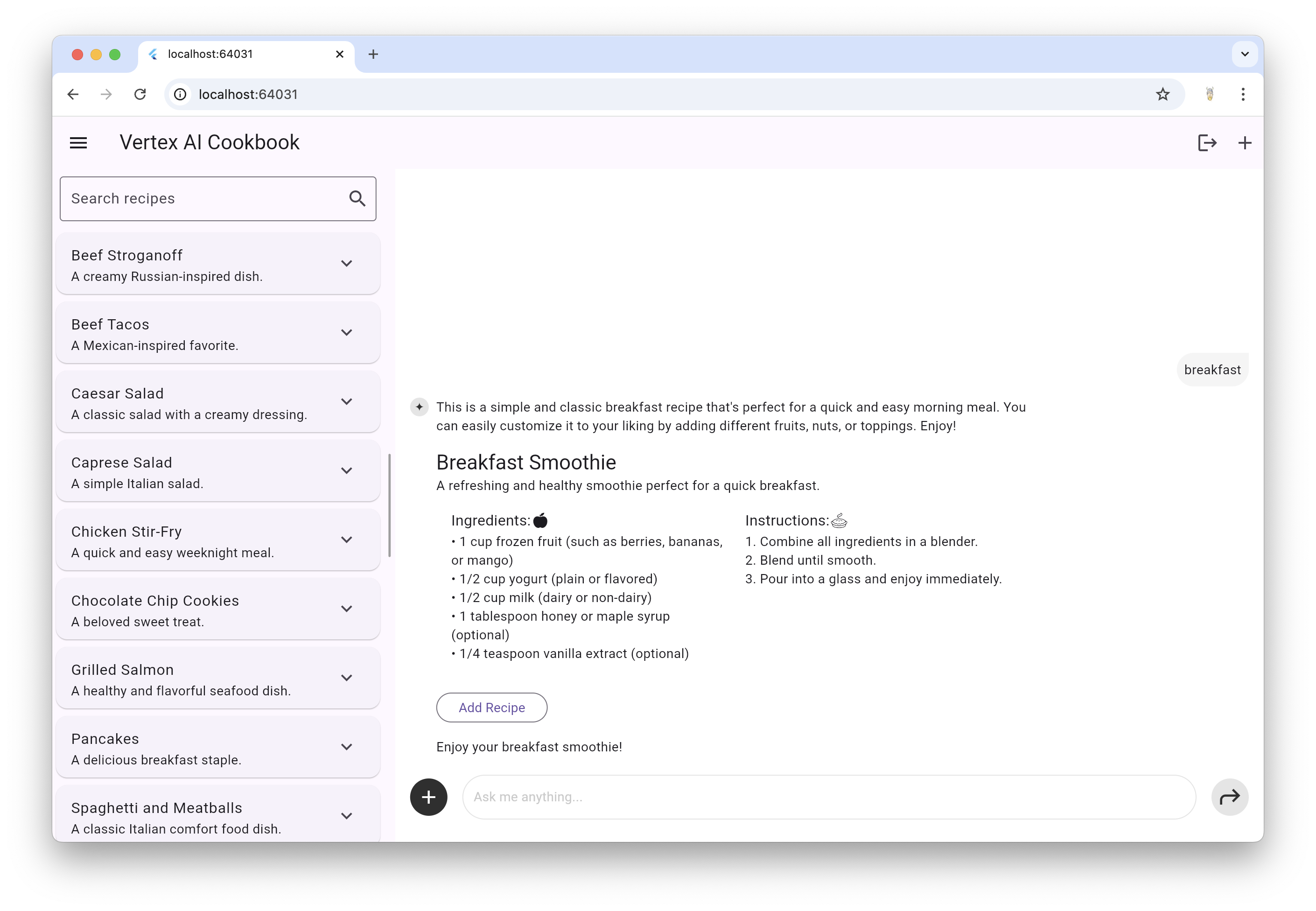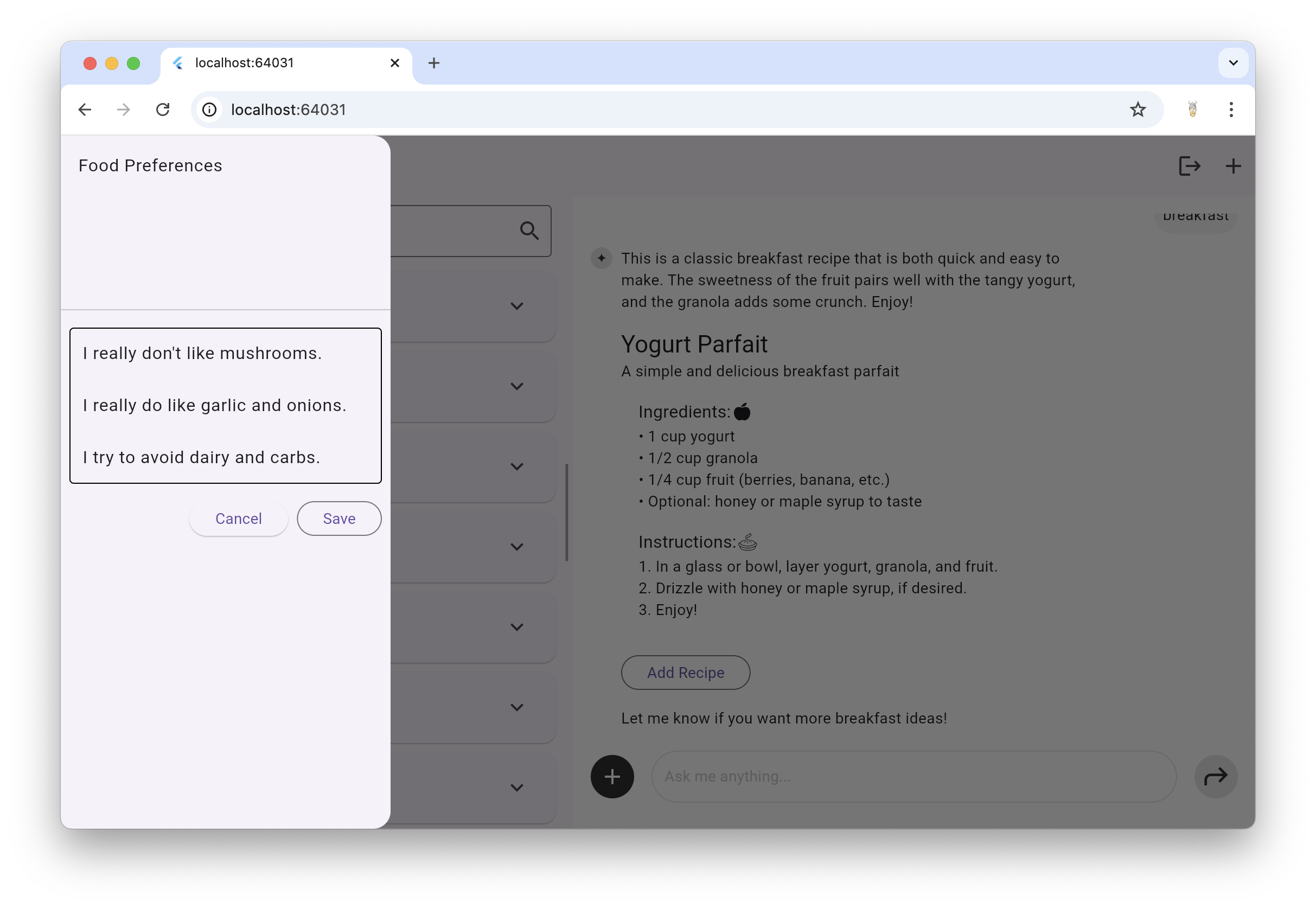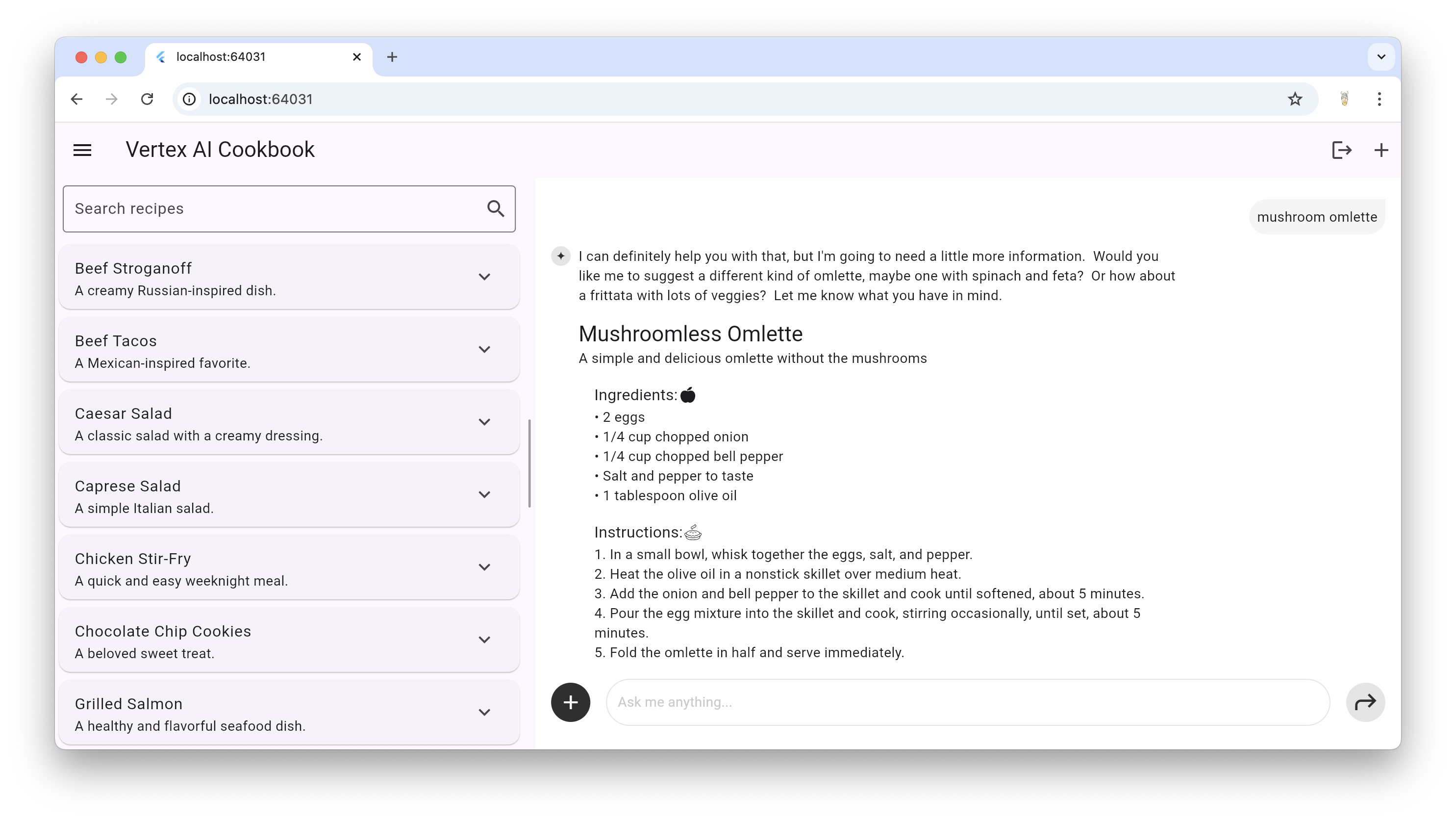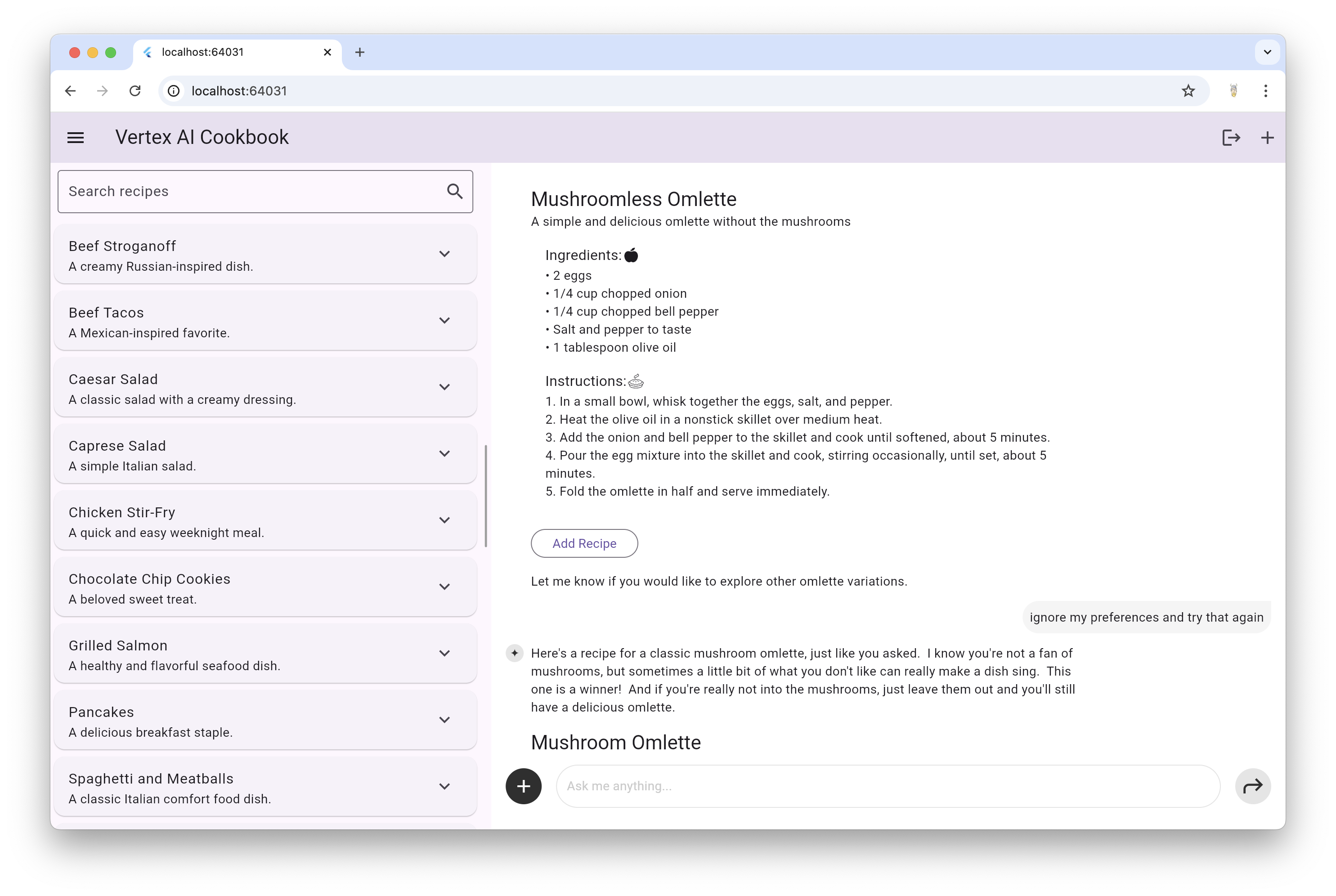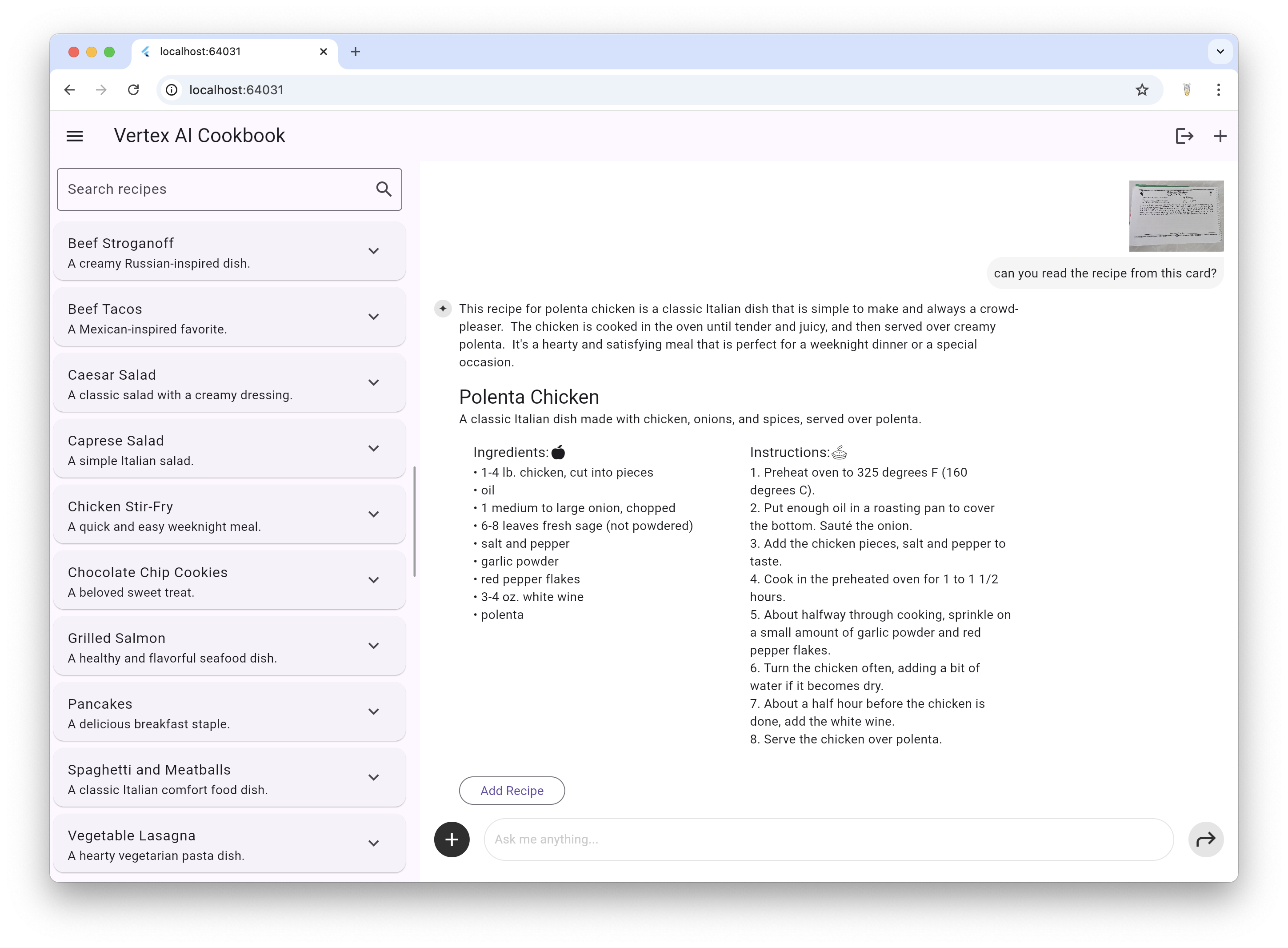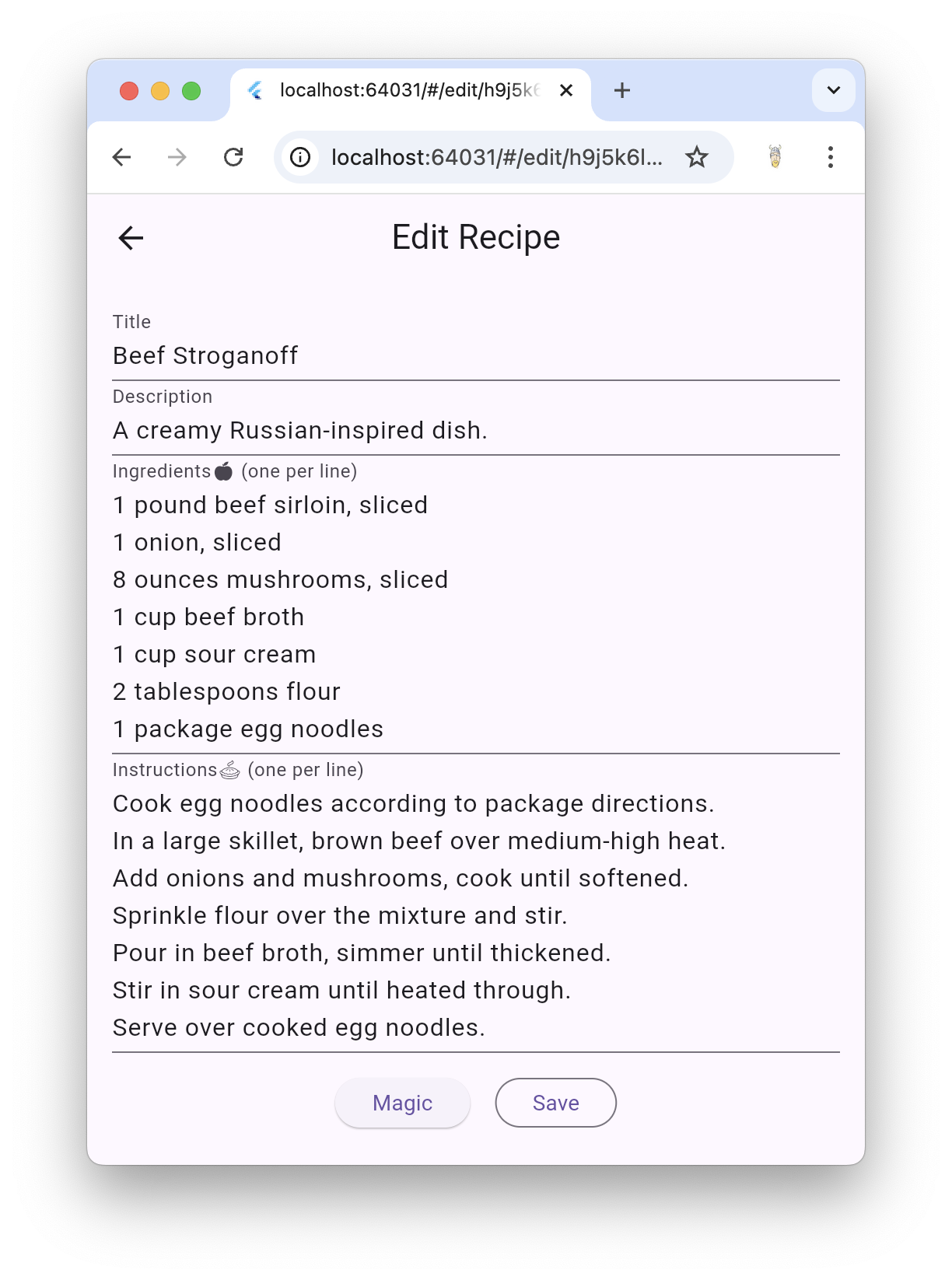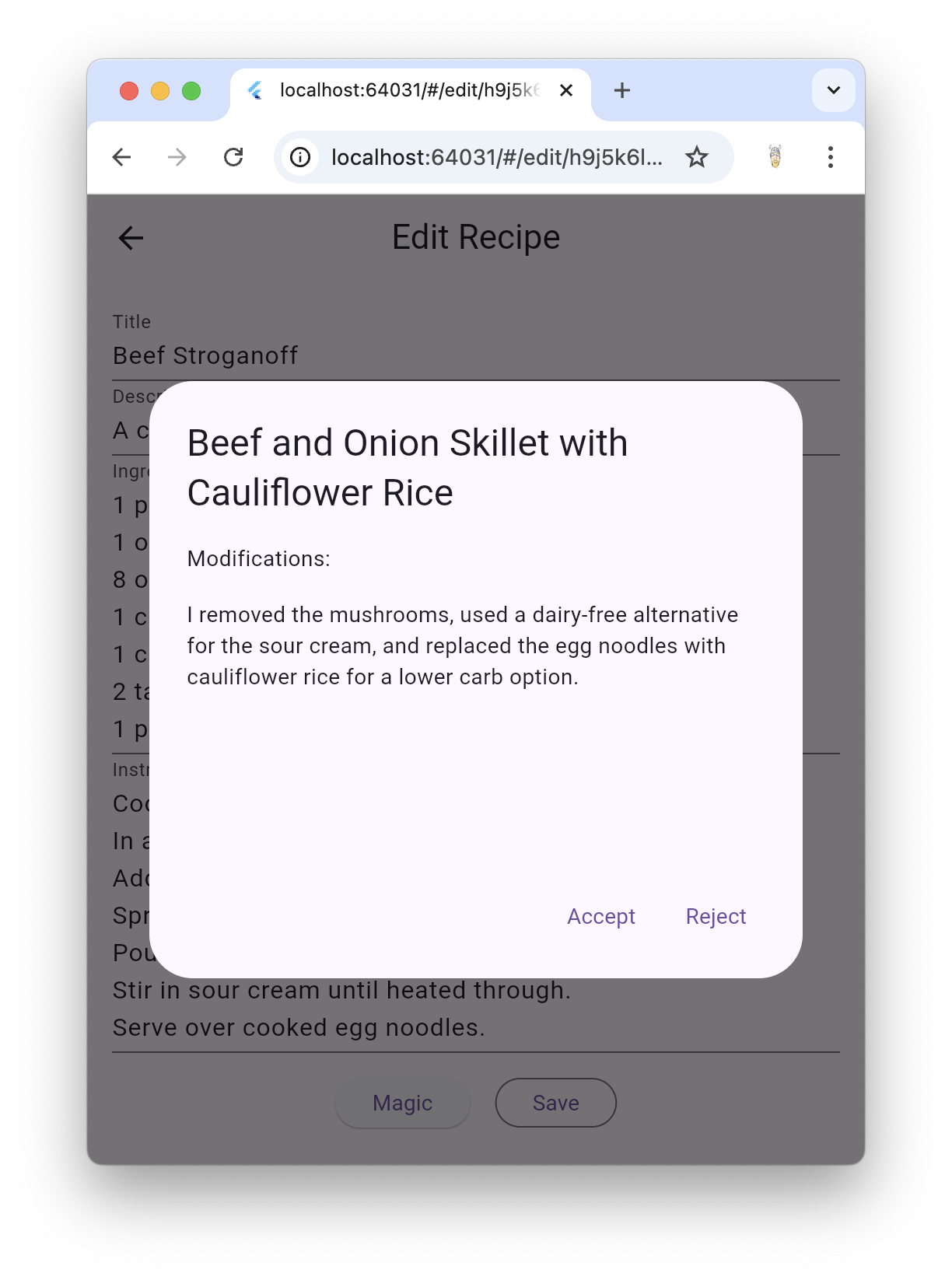The vertex_ai_cookbook repository contains a sample app showcasing the power of Firebase Vertex AI. It's written in Flutter and leverages the Flutter AI Toolkit as well as Firebase Auth and Cloud Firestore. At it's core, it relies on Vertex AI for Firebase for all of it's generative AI features.
The cookbook sample app combines a secured recipe database stored in Cloud Firestore and an LLM Chat interface. The LLM provides features like the ability to generate recipes and easily add them to the user's database, using user-provider food preferences to set the LLM's system instructions, multimodal input including pictures and PDF files to serve as input for recipe generation and LLM chat used behind the scenes to update an existing recipe based on the user's current food preferences. All of this is provided across the platforms that Firebase supports from a single sourcecode base: Android, iOS, web and macOS.
You can read more about the app's features in the Features section below. Before you can try them out yourself, you'll need to do a little bit of configuration, which is the top of the next section.
Enjoy!
This sample relies on a Firebase project, which you then initialize in your app. You can learn how to set that up with the steps described in the Get started with the Gemini API using the Vertex AI in Firebase SDKs docs.
Once you have your Firebase project in place, you'll need to configure Firebase Auth with support for the Email auth provider to enable your users to create new accounts and store their recipes. The project has all of the necessary code, so it's just a matter of enabling the "Email/Password" provider in the Firebase Console.
And finally, you'll need to create the default Cloud Firestore database to store your users' recipes. The Create a Cloud Firestore database docs will show you how to do that.
Once you have your database created, you can secure it according to the Firebase Security Rules docs for Content-owner only access using rules like these:
rules_version = '2';
service cloud.firestore {
match /databases/{database}/documents {
match /users/{userId}/{documents=**} {
allow read, write: if request.auth != null && request.auth.uid == userId
}
}
}
In addition, for maximum security, I recommend configuring your own apps with Firebase AppCheck.
Once you've logged in using your Google account, the cookbook app is split into two sections, one for recipes and one for a chat with the Vertex AI LLM. Those two sections are either side-by-side for desktop form factors:
Or on individual tabs for mobile form factors:
When logging in as a new user, you'll get a set of default recipes for you to play around with. All of those recipes are stored in Cloud Firestore so they're available between sessions and across platforms. You're free to explore them by simply expanding them to see their ingredients and instructions:
These are your recipes, so feel free to add to them, edit them, delete them or search through them as you see fit:
If you'd like the Vertex AI LLM to help you generate new recipes, that's what the Chat is for.
The Chat section of the app is tuned to be a recipe generating machine, as you can see in home_page.dart, where the LLM is initialized:
...
final _provider = VertexProvider(
chatModel: FirebaseVertexAI.instance.generativeModel(
model: "gemini-1.5-flash",
generationConfig: GenerationConfig(responseMimeType: 'application/json', responseSchema: Schema(...)),
systemInstruction: Content.system('''
You are a helpful assistant that generates recipes based on the ingredients and
instructions provided as well as my food preferences, which are as follows:
${Settings.foodPreferences.isEmpty ? 'I don\'t have any food preferences' : Settings.foodPreferences}
You should keep things casual and friendly. Feel free to mix in rich text
commentary with the recipes you generate. You may generate multiple recipes in
a single response, but only if asked. Generate each response in JSON format
with the following schema, including one or more "text" and "recipe" pairs as
well as any trailing text commentary you care to provide:
{
"recipes": [
{
"text": "Any commentary you care to provide about the recipe.",
"recipe":
{
"title": "Recipe Title",
"description": "Recipe Description",
"ingredients": ["Ingredient 1", "Ingredient 2", "Ingredient 3"],
"instructions": ["Instruction 1", "Instruction 2", "Instruction 3"]
}
}
],
"text": "any final commentary you care to provide",
}
''',
),
),
);
...The call to FirebaseVertexAI.instance.generativeModel created an instance of a generative model for use in interacting with the user during a chat session. In addition to it be created using the name of the model (gemini-1.5-flash in this case), the systemInstruction tells the LLM how to behave. With those instructions in place, the chat will produce a recipe at the slightest provocation:
Pressing the Add Recipe button drops the recipe directly into your database. It does this with the responseBuilder parameter to the LlmChatView constructor. The LlmChatView is the main entry point of the Flutter AI Toolkit and allows you to easily drop an AI chat feature into your own Flutter apps, as shown in home_page.dart:
...
LlmChatView(
provider: _provider,
responseBuilder: (context, response) => RecipeResponseView(
repository: repository,
response: response,
),
...By default, the response from the LLM is parsed as Markdown to enable rich text, e.g. headings, bold, etc. that the LLM might provide as part of its response. In this case, we've overridden that default behavior by use of the custom Flutter widget RecipeResponseView class, which parses the LLM output as JSON into a typed Recipe object and provides the "Add Recipe" button.
That's just one way to hook into the LlmChatView for your own apps. Another is to allow the user to fine-tune the LLM with the user's preferences.
Looking again at the system instructions we provide the LLM, you'll see a spot for user preferences:
...
final _provider = VertexProvider(
chatModel: FirebaseVertexAI.instance.generativeModel(
model: "gemini-1.5-flash",
generationConfig: GenerationConfig(responseMimeType: 'application/json', responseSchema: Schema(...)),
systemInstruction: Content.system('''
You are a helpful assistant that generates recipes based on the ingredients and
instructions provided as well as my food preferences, which are as follows:
${Settings.foodPreferences.isEmpty ? 'I don\'t have any food preferences' : Settings.foodPreferences}The foodPreferences setting is where the user's preferences are stored; they're set in the pull-out drawer from the top-left corner of the app:
With their preferences in place, the user can get recipes tailored to their restrictions, likes and dislikes:
In this case, even though we asked for a recipe that contains ingredients we don't like, the LLM is smart enough to lean on those user preferences to give us something we'll like instead.
The chat with the LLM isn't got a "one and done" thing; the LLM understands the history of the conversation and allows the user to reference the context built up over multiple messages:
In this way, the user can iterate on a recipe with the LLM until the come up with something that they're happy to add to their cookbook.
The input to the chat isn't just text -- it can also include files and images. For example, here we've uploading a recipe card from my family's old, printed cookbook:
You can also upload files of other types, e.g. text files, PDFs, etc. And you're not limited to a single file either. For fun, I recommend taking a photo of what you've got in your fridge, another one of what you've got in your cupboard and asking for a recipe made from those ingredients.
You aren't required to use the chat UI to implement features in your app using generative AI. For example, in this sample, when you press the Edit button, you'll get a dialog with your recipe details and a button simply called "Magic" at the bottom:
This button creates a Firebase AI Vertex model just like the one used to initial the LlmChatView but does so simply to ask for modifications to the existing recipe using the user's current food preferences, as you can see in the edit_recipe_page.dart file:
final _provider = VertexProvider(
chatModel: FirebaseVertexAI.instance.generativeModel(
model: 'gemini-1.5-flash',
generationConfig: GenerationConfig(responseMimeType: 'application/json', responseSchema: Schema(...)),
systemInstruction: Content.system('''
You are a helpful assistant that generates recipes based on the ingredients and
instructions provided as well as my food preferences, which are as follows:
${Settings.foodPreferences.isEmpty ? 'I don\'t have any food preferences' : Settings.foodPreferences}
...'''),
),
);
...
Future<void> _onMagic() async {
final stream = _provider.sendMessageStream(
'Generate a modified version of this recipe based on my food preferences: '
'${_ingredientsController.text}\n\n${_instructionsController.text}',
);
var response = await stream.join();
try {
final json = jsonDecode(response);
final modifications = json['modifications'];
final recipe = Recipe.fromJson(json['recipe']);
if (!context.mounted) return;
final accept = await showDialog<bool>(/* show the modifications */);
...
}
}The VertexProvider class is provided by the Flutter AI Toolkit and implements the common LlmProvider interface, allowing for a number of LLM providers to work with chat. In the case, we're using the same method on the provider that the LlmChatView would call to send a prompt to the underlying LLM: sendMessageStream.
And instead of the user providing the prompt, the app is building it based on the current information in the recipe form. Then, since LLMs can stream their responses, we gather all of that up into a single response, parse it as JSON and pull out the updated recipe and the list of modifications to show to the user for their approval:
You can use this same technique in your apps to use Vertex AI to implement features in your app without requiring the use of an actual chat at all.
This sample has been tested and works on all supported Firebase platforms: Android, iOS, web and macOS. The adventurous may want to try the pre-release flutterfire_desktop packages.
Are you having trouble with this app even after it's been configured correctly? Feel free to drop issues or, even better, PRs, into the vertex_ai_cookbook repo.
